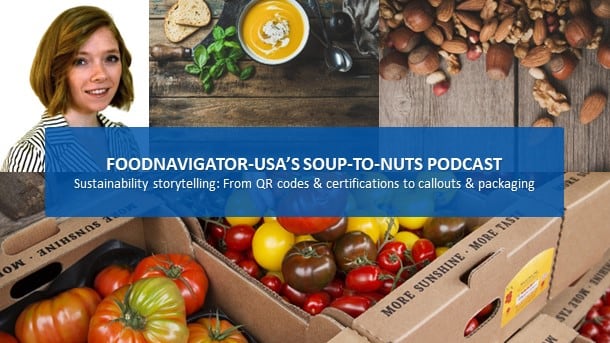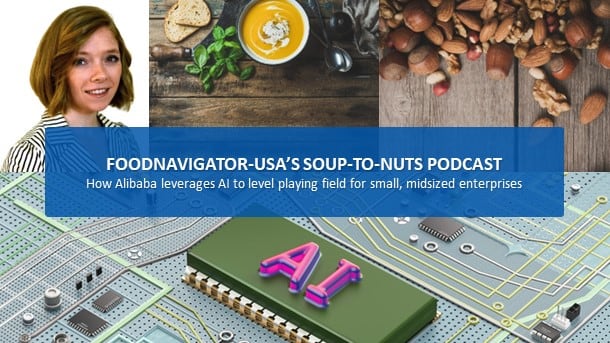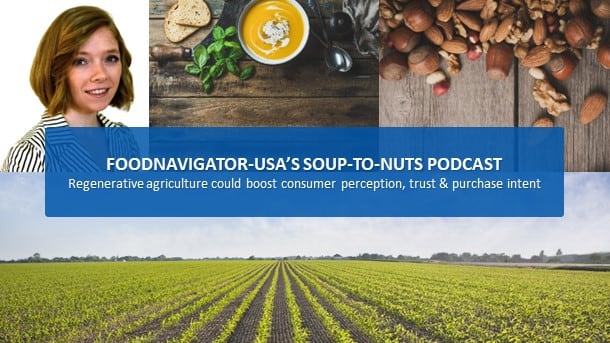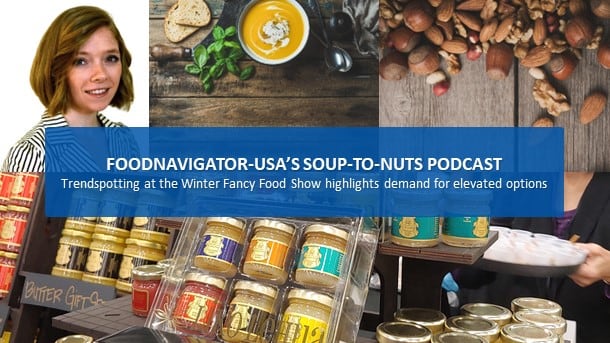The challenge for brands, according to Laurie Demeritt, CEO of research and consulting firm The Hartman Group, is effectively communicating how their products are better for the planet or farmers, which are complex concepts that don’t always fit neatly on a package.
At the Winter Fancy Food Show, Demeritt explained packaging, and whether it is recyclable or compostable or made with reduced or no plastic, is a primary way consumers evaluate a product's sustainability. Next, she said, they look at the ingredients and whether they were grown sustainability, which many consumers perceive as also being healthier for them. Finally, she said, consumers are thinking about workers, and whether they are paid and treated fairly.
In this episode of FoodNavigator-USA’s Soup-To-Nuts Podcast, brands at the Winter Fancy Food Show share how they approach sustainability and how they explain it to consumers. The CEO of Snacktivist shares how she talks about the complex issue of regenerative agriculture -- a buzzy term bandied about by the industry that hasn’t quite broken through to the consumer the same way as organic. We also talked with the owner of nutraberry, which upcycles berry seeds to create products that are better for people and the planet, Seal of the Seasons, which focuses on local distribution to reduce emissions, and Copper Moon Coffee about how it uplifts and creates new opportunities for farmers. Others showcased how they are using new technology to reduce thier footprint on the farm or increase biodiversity.
[Editor’s note: Never miss an episode of FoodNavigator-USA’s Soup-To-Nuts Podcast – subscribe today.]
Consumers are drawn to regenerative agriculture, but often don’t understand it
Founded in 2015 to help foster a more regenerative food system by creating consumer demand for more biodiverse crops, Snacktivist uses nutrient dense, environmentally-friendly crops that may be unfamiliar to create products consumers already know and love.
“Snacktivist is a food innovation company, and our goal is to elevate crops that have an important role to play in regenerative food systems, but don’t end up on our modern plates very often. So, we take crops like sorghum, millet, teff and different legumes and we put them into products that people find to be familiar, like pancake mix,” pizza crust and falafel mix, CEO Joni Kindwall-Moore told FoodNavigator-USA.
After launching Snacktivist, she said she quickly realized how important – and difficult – explaining regenerative agriculture to consumers is, and so she simultaneously founded a second company that leverages blockchain and QR codes to better educate shoppers and further drive demand for regeneratively farmed products.
“The storytelling piece is something I am so passionate about, because I know so many people that are doing incredible work in the regenerative world, and their story never gets out. It doesn't get beyond the package. So at Snacktivist, we literally have built our whole company around that storytelling piece. We call it regenerative by design, and all the things that we do, from ingredients to branded products is all around, like figuring out how we can make the story of regeneration come to life and tastes delicious,” she said.
The answer for Snacktivist is to place QR codes on the front of packages so that consumers can easily scan for more information without even picking up the produdct.
Snacktivist also relies on more common storytelling tools, including certifications. But unlike many brands, Kindwall-Moore displays multiple certifications for regenerative agriculture because she doesn’t want to limit the movement.
While Snacktivist started as a consumer-facing brand using regenerative crops, the company is expanding to become an ingredient supplier to help more brands meet the growing demand for regeneratively farmed food.
Upcycled Certified continues to gain traction
Another prominent sustainability trend at the Winter Fancy Food show was to showcase how products upcycled would-be wasted byproducts into something delicious and nutritious for people.
Among these was Washington state based nutraberry, which owner David Wishnick, explains creates better-for-you products from berry seed by-products.
He explains that 95% o the raspberries grown in the US are grown in Washington State, and many are used to create seedless purees. Recognizing that the would-be wasted seeds are packed with unsaturated fatty acids, polyphenols and fiber, nutraberry presses the seeds for oil and micronizes the defatted berry seeds to create powders that can easily be added to products for a boost of prebiotic fiver and polyphenols.
Seal the Season plays on a national stage, but keeps production, distribution local
The idea of eating locally to limit emissions and environmental impact isn’t new – but it is more often used by restaurants that cater to their immediate communities rather than packaged foods which are more traditionally produced for broad distribution.
Frozen fruit manufacturer Seal the Season, however, sets itself apart as a national CPG player that takes a local approach to production and distribution in order to keep the planet as a priority at every step of its business.
Company founder and CEO Patrick Mateer explains how this strategy not only is better for consumers, producers and the planet, but also is helping him secure funding and shelf space.
“We believe that locally grown food is better, and so we partner with family farmers across 17 different states, pretty much most of the country, and we source the food locally, freeze it locally and the package it locally and only distribute it locally or regionally,” which USDA defines as within 400 miles, he told FoodNavigator-USA.
By keeping it local, Mateer says the company offers consumers better flavor, minimizes its carbon footprint so that for every two pound bag the company sells locally it offsets about 1.06 pounds of greenhouse gases that would come from international transportation, and helps cultivate local economies.
Mateer said some retailers have begun asking the company for carbon footprint analysis when they consider their resets and what to stock, and others – like Whole Foods – offers loans or local businesses.
Copper Moon: Sustainability sells coffee
When family-owned Copper Moon Coffee rebranded in January 2020 after more than 10 years of operating, it did so in part to better highlight its sustainability program and its foundational value to source “premium, sustainably grown Arabica beans from farmers across five continents.”
Company VP of Sales & Marketing Nick Thompson explained the company did this in part because it sees the “right thing to do” as “table stakes,” but also because research from the National Coffee Association found that sustainability is a top priority for coffee consumers.
According to NCA, sustainability and worker welfare are within the top five reasons that consumers choose coffee – the first being the roast level and the second being whether is ground or whole bean.
To meet this demand, Rising Moon works with women coffee farmers to provide additional education, health benefits and empowerment through financing and additional demand.
Other exhibitors at the show called out how they are working with growers to more sustainably produce, harvest and grow products, such as by using solar panels, low-drip irrigation or drought-resistant crops. Many more highlighted organic and regenerative farming tactics, like crop rotation and increased biodiversity, or called out if their packaging was compostable or recyclable.
While each of these call-outs can represent complicated concepts, the prominence with which they were displayed suggests consumers care and, even if they don’t fully understand sustainability claims, yet, they can sway consumers to buy one product over another or trial something new.




